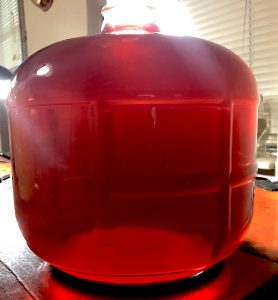
Black Cherries are coming into season. NOTE: The fruit is not pointed. Photo by Green Deane
Black cherries (Prunus serotina) are ripening, about a month late. Like chokecherries Black Cherries are bitter when ripe but can also have a some sweetness. Across the garden from where I grew up in Maine there were loads of chokecherries (Prunus virginiana) every year, Pounds of them, all bitter enough to choke you, hence the name. One way to preserve the calories and nutrients from these small cherries was to make wine out of them.They might not have tasted better as wine but one did not care. Their wilted leaves and seeds were always a cyanide threat to our horses. Locally one looks for black cherries to ripen in April about the same time as blueberries and blackberries. But I found my first ripe ones this past week.
Here in central Florida the most common edible cherry we see is the Black Cherry, though it grows throughout the eastern half of North America, lower parts of New Mexico and Arizona then south into Mexico and beyond. It has been naturalized in Europe. It’s easy to identify. Look at the back of several leaves. On other than a new leaf the mid-rib underneath will have hair on either side near the stem, blond when young turning rust colored to black when old.
Florida is the end of its Black Cherry’s range. Often its leaves are more lance shaped here than usual and can resemble the pin cherry (Prunus Pennsylvania) which does not grow this far south. So if you’re in Florida and you see a bird picking a little cherry it’s an odds on favorite to be the Black Cherry. Unlike the chokecherry, the Black Cherry is a favorite native tree. It has been used for food, woodworking and landscaping. Its inner bark has been concocted for centuries to make a cough syrup. While the Black Cherry makes a fast-growing attractive landscape tree, it is sometimes skipped over because it drops cherries and formal gardeners often don’t like that, though the birds and animals do.
Black Cherry fruits are important food many birds and mammals. Numerous songbirds feed on Black Cherries as they migrate particularly farther north in the fall. Among the birds who favor the Black Cherry are the American robin, brown thrasher, mockingbird, eastern bluebird, European starling, gray catbird, blue jay, willow flycatcher, northern cardinal, common crow, waxwings, thrushes, woodpeckers, grackles, grosbeaks, sparrows, and vireos. Black cherries are also important in the diets of the ruffed grouse, sharp-tailed grouse, wild turkey, northern bobwhite, and greater and lesser prairie chicken. Animals that like the fruit include the red fox, raccoon, opossum, squirrels, rabbits and bears. White tail deer eat the leaves and twigs. Clearly a tree to watch if you want to see wild life.
Don’t confuse Black cherry or chokecherry with the Carolina cherry laurel (Prunus caoliniana.) which is toxic with cyanide. It’s fruit is pointed and crushed leaves smell like almonds.

Chickasaw Plum leaf tips have red terminal glands. Photo by Green Deane
This was a “Prunus” foraging week. While rummaging around my usual class locations I sampled Chickasaw Plums. They are just beginning to ripen and should be around for about a month. The Chickasaw Plums were not completely ripe but give them a week or two. Black Cherries — above — are also ripening but are often more difficult to find because the birds also like them. Cherries and plums are in the same genus, Prunus, so it’s not surprising they are ripening at about the same time. Also setting fruit are the Flatwood Plums but they are different story and are included in my related article. I have a video on the Chickasaw plum here, Black Cherry here. To read about the Black Cherry go here, the Chickasaw Plum, here.

Podocarpus is setting. Photo by Green Deane
It’s a long ways to August but the Podocarpus is making seeds and that means edible arils in a few months. The species is a bit strange in that we don’t eat the mildly-toxic seed. We eat the aril next to it which are very grape-like. They can be used as grapes, eaten off the bush or made into jelly and wine et cetera. The seeds are listed as toxic but I know of an adult who ate two at one time and had no issue. That said, don’t eat the seeds. When the Podocarpus fruits can be something of a guess. Locally I look for them in August. The fruit can last several weeks and are edible even when they begin to dry and look like raisins. Oddly, in a local park in downtown Winter Park, a few Podocarpus have escaped trimming and have grown into moderate-size trees. Those fruit in December and my only guess as to why is perhaps they are a different species. My video on Podocarpus is here and you can read about it here.

Two and a half gallons of Jambul Wine before racking. Photo by Green Deane
If any of you follow my Facebook page you will know I resumed making wine. I did it for literally 30 years. When I moved eight years ago I stopped but the Covid-19 lockdown got me back into it. (Couldn’t go too many places and there were fruit trees ripening in the neighborhood. Ya work with what ya got.) I actually kept most of the equipment and have made up for lost time with several musts going. Only two surprises so far. I misread a float that you use to record at the beginning and end of a fermentation to know how much alcohol and sugar you have. It indicated a reading that defied the laws of physics of this universe until I realized with older eyes I was missing a decimal point… or is it dismal point?… dim-sal point? And a batch of orange wine was lollygagging so I gave it a stir then it geysered onto the floor. Perhaps why I stopped wine making is coming back to me now… I am working on some grape wine. I’m not as bad as Tom Good on the British show Good Neighbors. He was (in)famous for his “pea pod wine.” I never made a video on crafting wine but I did one on making real vinegar from scratch. I also have one on making a quick one-week hard cider.

Blue Porterweed blossoms taste like raw mushrooms.
Do you like mushrooms but want to avoid some of dangers that come with fungi foraging? Then there is a subtle solution: Blue Porterweed. Found in flower gardens around the world and native to Florida the Blue Porterweed earned its name as a source for tea that tasted like porter beer. Someone had the fermenting idea to add yeast and sugar to a lot of tea and get a brew that tastes similar to porter beer, hence the name. The flower garden variety usually grows up and the local native grows horizontally. The blue flowers, raw, have a subtle flavor of mushrooms. You can read more about the Blue Porterweed here. Oh, and how did porter beer get its name? The same way porter steak did. Porters — baggage handles in old central London — worked all hours and needed quick food. Shops set up to meet that need and out of them came several dishes and named items.

Foraging classes are held rain or shine, heat or cold. Photo by Nermina Krenata
Foraging classes: Will have a foraging class on both coasts this weekend.
Saturday, May 25th, Ft. Desoto Park, 3500 Pinellas Bayway S. St. Petersburg Fl 33715. There is an additional small entrance fee to the park. 9 a.m. to noon. Meet at the fishing pier parking lot. It’s a large parking lot, meet near the bathrooms.
Sunday, May 26th, Wickham Park: 2500 Parkway Drive, Melbourne, FL 32935-2335. Meet at the “dog park” inside the park. 9 a.m. to noon.
For more information on these classes, to prepay or sign up go here. The cost is $30 per adult (the class is usually three hours long and examines five-dozen or so species.) If cost is a hardship email me at: Green Deane@gmail.com.

Green Deane Forum
Tired of Facebook and want to identify a plant? The Green Dean Forum is up and running again. Have you come to dislike Facebook, then join us on the forum. Perhaps you’re looking for a foraging reference? You might have a UFO, an Unidentified Flowering Object, you want identified. On the Green Deane Forum we — including Green Deane and others from around the world — chat about foraging all year. And it’s not just about warm-weather plants or just North American flora. Many nations share common weeds so there’s a lot to talk. There’s also more than weeds. The reference section has information for foraging around the world. There are also articles on food preservation, and forgotten skills from making bows to fermenting food.

You get the USB, not the key.
172-video USB would be a good end of spring present and is now $99. My nine-DVD set of 135 videos has been phased out. The USB videos are the same videos I have on You Tube. Some people like to have their own copy. Most of the 172 USB videos have to be copied to your computer to play. If you want to order the USB go to the DVD/USB order button on the top right of this page. That will take you to an order form.

Now in its second printing.
274 plants, 367 pages, index, nutrition charts and color photos. It’s available in many locations including Amazon. Most of the entries include a nutritional profile. It can also be ordered through AdventureKeen Publishing.
This is weekly newsletter #602. If you want to subscribe to this free newsletter you can find the sign-up form in the menu at the top of the page.
To donate to the Green Deane Newsletter click here.

